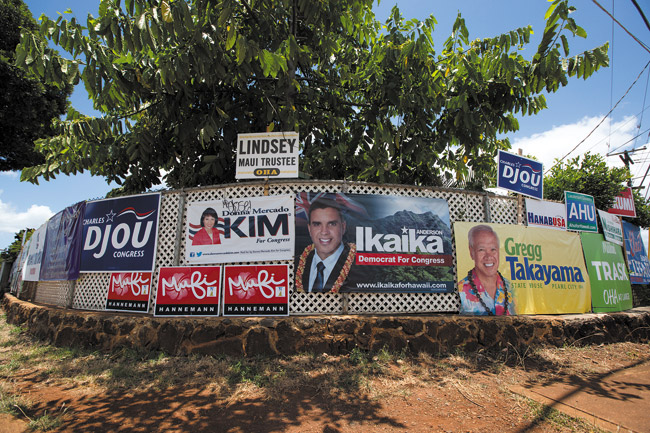Reading The Early Political Signs
As a certified political analyst, I am frequently asked to read the political skies, as in: “Where are the planets Hanabusa and Schatz in the night sky?”
Or, more recently, “Is the star Ige rising? Any chance it will burn up as it draws near the Abercrombie sun?”
Or, “What of the constellations Aiona, Hannemann and Aiona? Which shines brightest in August? In November?”
I, of course, stroke my beard, take on a mien as wise as my befuddled 70-year-old brain will allow, and mutter, “The June skies are cloudy. Hard to tell. Hard to tell. Let me look at my charts. I’ll get back to you.”
My charts, of course, are not contained in oversized, weighty tomes. (No. Shhhh. Don’t tell anyone. Promise?)
My charts are to be found at strategic corners, on chain link, cement block, and wooden fences. They crop up out of mock orange hedges and rural lawns.
They are the campaign signs of a Hawaii political season, and they are everywhere. Everywhere. And, since the filing deadline June 3, they’ve been propagating faster than bomber cockroaches in Kona weather.
Particularly on those strategic corners, like the confluence of Moanalua Road, Waimano Home Road and Noelani Street in my own beautiful Pearl City. There, on the ewamauka corner of the intersection, campaign signs of every color, size, and iteration wrap around a chain link fence.
A Poti (state House) banner, then a Schatz banner, followed by a three-color Kim banner over three discreet Mufi signs. Then comes Ikaika in aloha shirt, blue blazer, and lei — all in glorious color; a Nishihara (state Senate) banner over two small Takayama (state House) signs; a Hanabusa banner on top of two small Tsutsui (lieutenant governor) signs.
Aha! A Tanabe for Governor banner, atop an Ohana Lottery banner. Tanabe, apparently, is running on a one-plank platform.
An Ige banner, surrounded by four small signs, two advertising Takayama, two Tsutsui. Hanabusa again. And Mufi. Two Mililani Trask for OHA signs. An Abercrombie banner.
Oho! Relief from politics at last: A banner that reads “Pearl City High School, Class of 1994, 20th Reunion.”
But then back to politics: Kim again, Djou, Mufi, Mufi, Mufi, Lindsey for Maui OHA delegate, another multicolored Ikaika banner, Hanabusa and Ahu (lieutenant governor), a smiling Takayama on a brilliant yellow banner, a Trask banner, a Takumi (state House) sign, an Elephante for City Council banner, and finally Tsutsui again, full-faced on a banner.
Whew! Every inch of this poor homeowner’s fence covered with the insatiable ambition of Hawaii politicians. In different neighborhoods the same sight will be found: different names but the same questing ambition.
Oh, I know. For most of you, they’re just a blur glimpsed out of the corner of your eye as you wait patiently for the traffic light to change. For me, however, a certified and highly credentialed political analyst, they provide the grist for penetrating analysis.
What, for example, is in a campaign color scheme? Hanabusa’s, Abercrombie’s, and Kim’s patriotic red, white, and blue? Takumi and Mufi take away the blue; Schatz’s pale blue and white; Takayama’s blinding yellow hues. Profound stuff, this.
Or their numbers? Who has the most campaign signs polluting our highways and byways? I confess that I count them.
Not literally, of course, but almost. How pathetic is that?
Still, the poet sayeth: “The fault, dear reader, is not in their stars, but in their political signage.”
Or something like that.
dbboylan@yahoo.com






